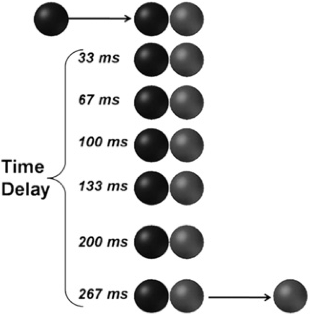This task was designed by Woods et al. (2014). Based on the Shallice (1964) launching experiment, this task measures time dependence in perceiving causation. Subjects view a short video which consists of a blue ball moving toward a red ball, which then moves after a period of 0-267.2 ms, divided in 16.7 ms intervals, creating 16 levels (see graphic below, taken from Woods et al. (2014)). Subjects asked to indicate whether or not the blue ball caused the red ball to move.

Total Items: 120
Completion Time: 8 minutes
Dependent Variable: Threshold of Causation Inference (ms)
This task is programmed in PsychoPy. Please contact me for task usage.
References
Shallice, T. (1964). The detection of change and the perceptual movement hypothesis. The British Journal of Statistical Psychology, 17(2), 113–135. doi:130.91.116.120
Woods, A. J., Hamilton, R. H., Kranjec, A., Minhaur, P., Bikson, M., Yu, J., & Chatterjee, A. (2014). Space, time, and causality in the human brain. NeuroImage, 92, 285–297. Space, time, and causality in the human brainhttp://dx.doi.org/10.1016/j.neuroimage.2014.02.015
Comments are closed.